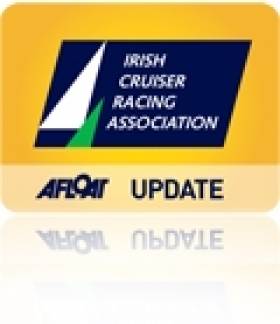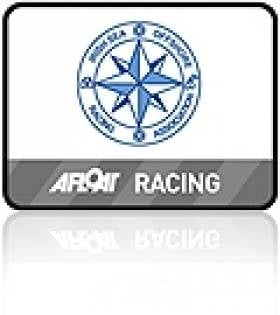Displaying items by tag: ISORA
Breezy Start Forecast for ISORA Race to Arklow
ISORA has released the 25–boat entry list for what's forecast to be a breezy start to tomorrow's second ISORA race from Dun Laoghaire to Arklow and back. Any boats visiting Dun Laoghaire are welcome to use the facilities of the National YC, says ISORA and NYC Commodore Peter Ryan. The race briefing will be held at Dun Laoghaire marina tomorrow morning at 0845.
New Trophy for Offshore Race from Cork to Dublin
A new sailing trophy will be awarded to the winning yacht in a new offshore race from Cork Harbour to Dublin as part of the build up to the Irish Cruiser Racer Nationals to be held on Dublin Bay from May 21-23.
The feeder Race will take place from Royal Cork in Crosshaven on Friday 14th May. Commodore's Cup team boats will use the passage as part of their offshore practice.The Race also can be used as a qualifier for next month's Round Ireland Race and it will also accomodate double handed entries.
111 boats have already entered the Liebherr Nationals from 21st to 23rd May in the Royal St George Yacht Club in Dun Laoghaire. Event organisation is in full swing to ensure a quality event both aflaot and ashore, says ICRA Commodore Barry Rose.
Entry forms and sailing Instructions will be available at the Royal Cork Yacht Club. Interested boats are requested to inform ICRA of their intention to compete. The ICRA perpetual offshore trophy will presented to the winning yacht.
After a record turnout for its first race of the season to Holyhead a week ago ISORA Commodore Peter Ryan has appealed for a similar effort for next weekends race from Dun Laoghaire to Arklow and back. This ISORA race will be run with the Lee Overlay/Royal Alfred Yacht Club 2010 Offshore Series race using the same start, course and finish. Boats may enter both series. Boats entered in the ISORA series only shall not be scored in the Lee Overlay/RAYC series nor are eligible for prizes in that series.
TIME OF START FOR ALL CLASSES
09.55 Warning signal - Class flags (Numerals 1 & 2) hoisted
09.56 Preparatory Signal - Blue Peter hoisted
09.59 Blue Peter down
10.00 Start – Class flags down
The start may be broadcast on VHF Channel 72.
STARTING LINE
The start line shall be located in Scotsman’s Bay in the vicinity of DBSC ‘Pier’ mark between the mast of a committee boat flying the RAYC burgee and a start mark at the port end. A boat shall not start later than 15 minutes after her Starting signal. Prior to the start of each race boats are requested to obtain acknowledgement from the Race Committee.
THE COURSE
1. STARTING LINE
2. Muglins to starboard
3. Arklow North to Port
4. Muglins to port
5. FINISH LINE
The Course will be confirmed at a briefing at 08.45 at the Marina offices and afloat to the competitors on channel 72 before the start.
SHORTENED RACES
The race may be shortened at a mark and will be signalled by calling the fleet on Ch 72. If the fleet doesn’t finish a race or shortened race, the race committee may take the result from the mark at which one third or more of the fleet round from the direction last mark.
Katanca Stays on Top in ISORA
A change in the finishing time of the winning sailing yacht in the first race of the 2010 ISORA series has led to a reissue tonight of Saturday's race results but the placings still stand. Double-handed entry, Katanca, an Elan 31 sailed by Barry O'Connor and Paul O'Riain from the Royal Irish YC stay on top in the 20-boat fleet. The revised results are attached.
Records Broken For First ISORA Race
For the first time the overall race included "no spinnaker" and "short-handed" boats. The IRC rating allows this and ensures that every entry is competing for the coveted "Wolf's Head Trophy". The large fleet was divided in two classes with the break at rating 1.025 producing nearly an even divide of the fleet.
All week the weather forecast for the race was predicting ideal conditions. On the morning of the race there was not a breath of wind in the marina and there were mutterings from some boats about shortening the race. Fortunately, as the race was a qualifier for the Round Ireland Race, it had to remain at 75 miles length. By the time the large fleet gathered at the start there was 18k of wind. The forecast for 15-20k southerly winds was correct as the 22- boat fleet powered out of Scotsman's Bay towards the Kish Lighthouse. Rounding the Kish the fleet went onto a full beat down the 15 miles to the North India buoy. The wind
remained while the fleet rounded the North India but started to go light soon after. The leg to Holyhead was a very tight reach and those boats that chose to fly spinnakers lost out very soon after.
The approach to Holyhead was at its usual trickiest. The wind dropped and the light variable winds and the strong tides made it critical that the right approach was taken. "Tsunami", Vincent Farrell, made all the right decision in staying east of the rhumb line while crossing the Irish Sea and being south of Holyhead on the approach to the finish with a flooding tide. "Tsunami" took line honours while the tide changed against the remainder of the fleet. Barry O'Connor, sailing short handed in "Katanca" took 1st Overall and 1st Class2. Matt David in his Sigma 400 "Raging Bull" took first place in Class 1 and 2nd
overall. Of the 22 starters, only 3 retired but two of those, Neil Eathough, "Lancastrian" and single-handed Ciaran Hughes "Temper Tantrum", continued to Holyhead for the après race.
The finisher for the race was Rear Commodore of Holyhead Sailing Club, Geoff Garrod. For those boats who went ashore in Holyhead, Sailing Secretary and Past Commodore, Dawn Russell had arranged a great party. The hospitality shown in Holyhead was worth the frustration of the closing stages of the race and ISORA look forward to its next visit there on the 15th May for the ISORA and feeder race to the ICRA Championships in Dun Laoghaire.
The next race is a combined ISORA / RAYC Day race on the 8th May down to the North Arklow buoy and back to Dun Laoghaire. I ask those ISORA boats taking part in this race to also enter the Royal Alfred / Lee Overlay Series. This series is sponsored by Adrian Lee of Lee Overlay and the entry fee is very nominal.
Details on www.rayc.ie .
Fine Turnout for First ISORA Race
Irish Sea Offshore Racing Association
Irish Sea Offshore Racing Association
History
The germ of ISORA started after the war when Irish Sea racing was at an extremely low ebb, although there was a tradition of such races such as the Tranmere Sailing Club's Midnight Race, run since 1907, and the Llandudno Race run by the Royal Mersey Yacht Club as a feeder race for the Menai Straits Regatta.
In order to revive interest in offshore racing, Peter Brett and Mostyn Vicars formed the 'Merseyside and North Wales Joint Offshore Co-ordinating Committee' which laid the foundations of our present organisation. The following extract from the minutes defines its activities and make-up:-
"The purpose of the committee is to assist and encourage clubs in the Merseyside and North Wales area in the sponsoring of offshore races in the Irish Sea under the RORC rating and time scale. The Committee, which is composed of representatives of the RORC and certain local clubs, does not sponsor races itself. Offers from clubs in the district to sponsor such races will be very welcome, and every possible assistance will be given".
The statement of intent has been the basis os all our subsequent activities. Originally the races were confined to those offered by the Royal Mersey, Tramere, Royal Welsh, Royal Anglessey and Royal Dee Clubs, but by 1960 the objective of widened interest was being achieved and extra races under the burgee of South Caerarvonshire Yacht Club and Holyhead Sailing Club were included. The Merseyside and North Wales Joint Offshore Co-ordinating Committee continued to provide a central administration for all this activity, which by 1963 increasedto no less than twenty-one races. Such a programme was beyond the scope of the secretariat and it was feared that the original object of fostering interest might well be defeated through inadequate organisation.
At the annual meeting held at the Royal Mersey Yacht Club on 14th October, 1963 the Merseyside and North Wales Joint Offshore Co-ordinating Committee was dissolved and a new body to be known as the North West Offshore Association (NWOA) was formed. A committee under the Chairmanship of Michael Tomlinson was elected and they declared their aim:-
To organise, with the help of elected clubs, five offshore races each year. Four of those races were to be in excess of 70 miles, i.e. definitely offshore, and the fifth to be a RORC race in excess of 200 miles.
Still based mainly along the Lancashire and North Wales coastline, NWOA continued along the lines laid down by the founders, although a sixth race - the Tod Trophy, was included at a later date to allow the ever increasing 'B' fleet to have racing while their larger sisters were away taking part in the annual RORC event. Over the years it has become obvious that as well as good support for our races from the eastern shores of the Irish Sea, an increasing number of entries were from the Dublin Bay area. In 1971 these Irish entries equalled in number those from all other home ports.
It seems that once again the time had come to see if the NWOA needed bringing up to date, and so in line with tradition, a meeting was called at the Royal Mersey Yacht Club, to which representatives of almost every club around the shores of the Irish Sea were invited. It was suggested that it was time that the NWOA should widen its sphere of activity to include this whole area and representatives from the Ribble, Mersey, the Menai Straits, Anglesey, Cardigan Bay and the Isle of Man and the whole of Ireland's east coast agreed that this was a good idea, and an attempt should be made to produce an integrated racing programme over this area.
It was decided to change the name to the 'Irish Sea Offshore Racing Association' as the most suitable indication of the area in which the clubs are situated. It was also decided that it would be possible to extend the racing programme to include boats from the Isle of Man, the North of Ireland and the Ribble without seriously changing the traditional races (which had been enjoyed so much over the past few years), by including races which the clubs in these areas had run in the past and in which boats from each area should be asked to travel to starts away from home twice, take part in a RORC race (or its small equivalent) as well as starting twice from their home ports. It was also agreed that in 1972 racing should be offered for a third class - namely class 'C' entries to which would be restricted to boats that had not got divided underwater profiles.
At the beginning of the 1972 season, Sandy Taggart from the Clyde approached the English part of the association and asked if we would be willing to include certain Clyde races in our programme and this we agreed to do so. Since the early 70s a week-long offshore regatta has become popular and developed – The Captains Cup in the South of the Irish Sea and the Comet Wheel Series on the Clyde. From these two events the bienniel ISORA Race Week evolved.
Have we got your club details? Click here to get involved
The Clubs
South Caernarfonshire Yacht Club


























